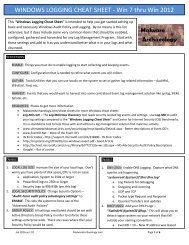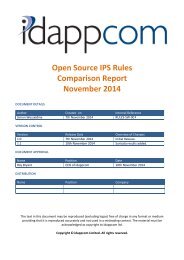Exploit Test Tool Manual
Exploit Test Tool Manual
Exploit Test Tool Manual
Create successful ePaper yourself
Turn your PDF publications into a flip-book with our unique Google optimized e-Paper software.
3 Details of individual tests<br />
In this section the details of the individual tests of the <strong>Exploit</strong> <strong>Test</strong> <strong>Tool</strong> will be presented.<br />
Run Windows Calculator (not an exploit)<br />
<strong>Exploit</strong> <strong>Test</strong> <strong>Tool</strong>:<br />
This test is not an exploit test, but a test to verify if the tool is able to start the Windows Calculator<br />
(%systemroot%\system32\calc.exe).<br />
Important: If the Windows Calculator cannot be started, none of the exploit techniques in the<br />
<strong>Exploit</strong> <strong>Test</strong> <strong>Tool</strong> can be reliably tested.<br />
Most exploit tests will start the Windows Calculator as proof of a successful exploit of a software<br />
vulnerability. Note that if the Windows Calculator can be started via an exploit, an attacker could have<br />
started some malicious code instead, using the exploit technique and a software vulnerability.<br />
Stack Pivot<br />
<strong>Exploit</strong> <strong>Test</strong> <strong>Tool</strong>:<br />
A common method for an attacker to control program execution involves creating a ‘fake stack’ using<br />
attacker-specified values. When the attacker tricks the victim computer into using a fake stack, the<br />
attacker can control the program execution.<br />
This specific test allocates a block of 64KB of memory on the heap and copies shellcode to that memory.<br />
Then it switches the stack pointer to the end of that memory block and starts the shellcode, which gives<br />
the shellcode a comfortably nice large stack for its operations.<br />
When calc.exe has been started, the <strong>Exploit</strong> <strong>Test</strong> <strong>Tool</strong> terminates via a call to ExitProcess().<br />
Stack Exec<br />
<strong>Exploit</strong> <strong>Test</strong> <strong>Tool</strong>:<br />
This test makes a piece of the stack memory executable via a call to VirtualProtect(). Then it copies<br />
shellcode to that part of the stack and jumps to the start of that shellcode. When calc.exe has been<br />
started, the <strong>Exploit</strong> <strong>Test</strong> <strong>Tool</strong> terminates via a call to ExitProcess().<br />
HitmanPro.Alert <strong>Exploit</strong> <strong>Test</strong> <strong>Tool</strong> <strong>Manual</strong> 1.5 Page 11







